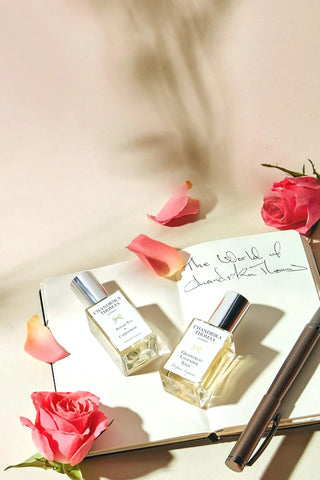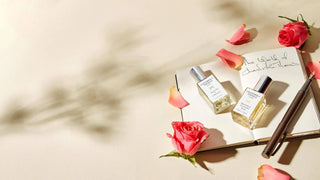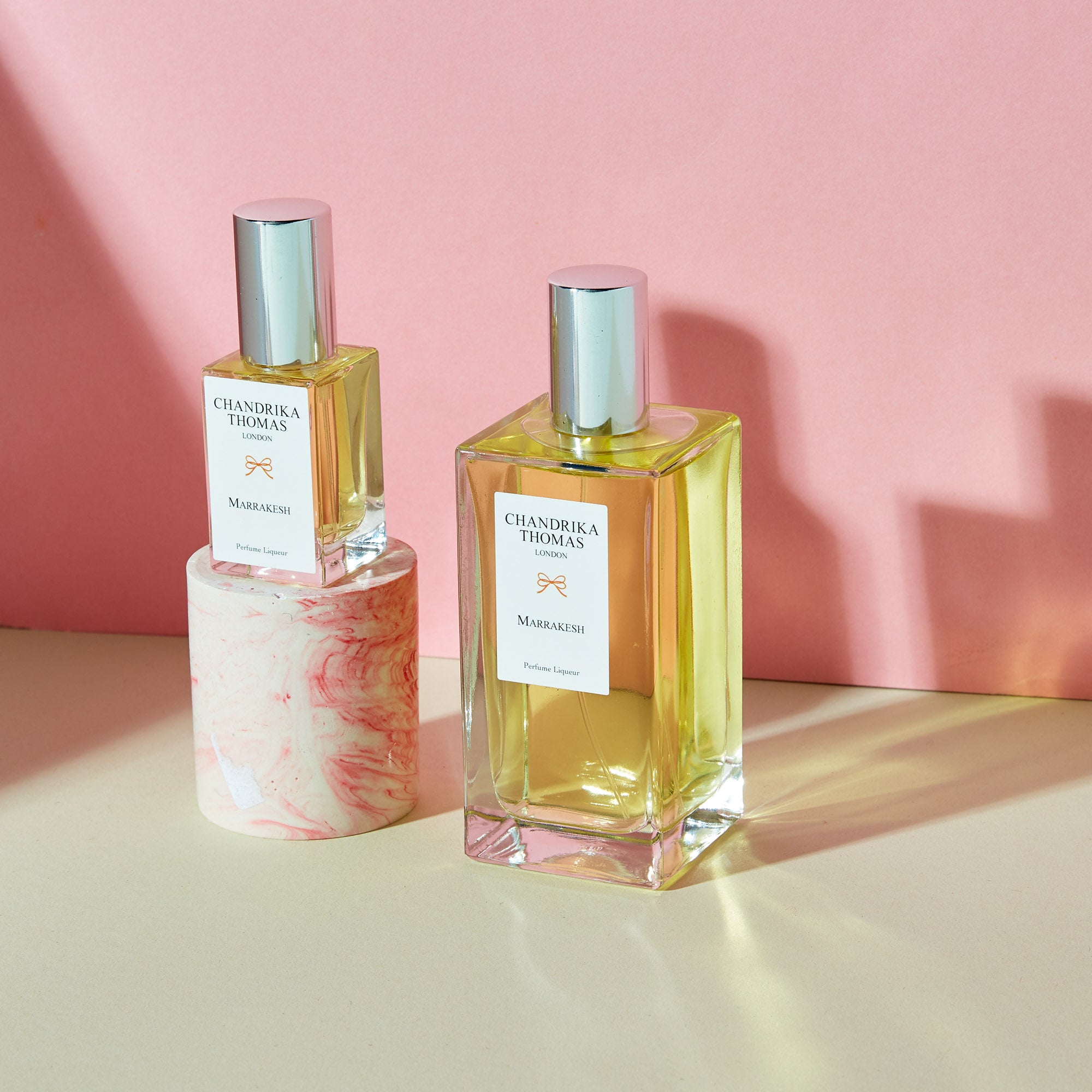From the temples of ancient Egypt to the ateliers of modern perfumers, spices have always been storytellers. A trace of cinnamon, a whisper of cardamom, or a spark of clove can transform not only a perfume, but the mood of a season. They speak of warmth, intimacy, and quiet luxury, making spiced perfumes some of the most enduring creations in the history of fragrance.
But what makes spices so magnetic in perfume? Why have they travelled through centuries, across empires and oceans, to remain central to the art of scent? And most intriguingly, why does a touch of spice feel as though it warms the skin itself? To answer these questions, we must follow their journey: from sacred rituals and bustling spice markets to modern fragrance laboratories.


Ancient Beginnings: Fragrance Born in Fire
The history of perfume is inseparable from the history of spice. The very word perfume comes from the Latin per fumum, meaning “through smoke.” Long before fragrance was bottled, it was offered to the fire as incense.
-
Egypt: Cinnamon, cardamom, and myrrh were burned in temples, with smoke believed to carry prayers to the gods. The famous Kyphi incense, a complex recipe of resins, honey, wine, and aromatics, was used both as a ritual offering and a nightly balm.
-
Mesopotamia: Priests burned resins such as frankincense and myrrh in ceremonies to sanctify space. Later, through trade, spices such as cinnamon and cardamom were introduced, enriching these rituals.
-
India: Cardamom and saffron were staples in Ayurveda, celebrated for their effect on both body and spirit. Spices were also distilled into attars with sandalwood oil, a practice that continues today.
-
China: Clove was introduced as early as the Han Dynasty, prized for both medicine and fragrance.
Spices were never simply pleasant smells; they were medicine, offerings, and luxuries. In many cultures, to perfume oneself with spice was to connect with the sacred.

The Spice Trade: Perfume as Wealth and Power
From the first millennium BCE onwards, aromatics became the lifeblood of global trade. Spices and resins were treasures, often valued more highly than precious metals. Entire empires rose and flourished on the movement of these goods, which were carried over land and sea along carefully guarded routes.
The Incense Route, stretching from the Arabian Peninsula through Petra and into the Mediterranean, carried frankincense and myrrh from Arabia. Cinnamon and cardamom, cultivated in India, travelled first by sea to Arabian ports before joining these land caravans, an early example of how maritime and overland trade intertwined.
In parallel, the Silk Road brought saffron from Persia, clove from the Moluccas, nutmeg from the Banda Islands, and pepper from India into the courts of Europe. These were exotic, rare, and potent symbols of wealth and connection to faraway lands.
In ancient Rome, cinnamon was so rare that it was valued higher than silver. Writers such as Pliny the Elder noted its extraordinary cost, and it was often reserved for the elite, emperors, nobles, and high priests. To wear cinnamon-scented oils was to announce one’s privilege, refinement, and status.
By the Middle Ages, the association between spice and protection had taken hold. Aromatic pomanders, ornate spheres filled with clove, cinnamon, and other spices, were worn around the neck or carried in hand. They perfumed the air but also served as talismans, believed to guard against plague and disease. For nobles and royals, the pomander became both a practical object and a sign of sophistication, a portable blend of fragrance and power.
With the Renaissance, Europe’s hunger for spice grew insatiable. Venice emerged as one of the continent’s most powerful spice and perfume capitals, controlling key ports that connected the Levant and the East. Venetian merchants grew wealthy distributing cinnamon from Ceylon, nutmeg from the Moluccas, saffron from Persia, and rosewater from the Levant. In aristocratic courts, perfumes made with these exotic ingredients became status symbols, luxurious vials of cinnamon-rose oil or saffron-infused water marked one as cultured, worldly, and supremely privileged.
Owning such fragrances was a declaration of access. To possess a perfume infused with saffron or cinnamon was to hold in your hand the outcome of perilous voyages, dangerous trades, and extraordinary expense. In many ways, spiced perfumes were the ultimate symbols of wealth, power, and worldliness, tokens of a global network that connected East to West through scent.

Distillation: Unlocking Spice for Perfumery
Perfume as we know it today owes much to the art of distillation, the ability to extract essential oils from raw materials. This technique transformed fragrance from incense smoke and unguents into liquid form, making it possible to wear perfume on the skin rather than only offer it to the gods.
The practice of distillation had existed in various forms in the ancient world, from Mesopotamian experiments with aromatic waters to Greco-Roman methods of concentrating wine and resins. But it was in the Islamic Golden Age that the process was refined into the steam distillation still used today. Avicenna (Ibn Sīnā, 980–1037 CE), the Persian polymath, perfected the technique specifically for delicate botanicals, applying it to roses to produce the first true rosewater and rose oil. His innovation allowed fragile floral notes, which could not survive burning or simple maceration, to be captured in their pure essence.
Once rose distillation was mastered, the same method was applied to spices and woods, unlocking new dimensions for perfumery:
-
Clove bud oil, rich in eugenol, with its warm, sweet, slightly medicinal depth.
-
Cinnamon bark oil, yielding cinnamaldehyde, is fiery, sweet, and instantly recognisable.
-
Cardamom oil, aromatic and creamy, with both a cool lift from cineole and smoothness from terpinyl acetate.
Before this, resins such as frankincense and myrrh were prized as incense and ritual offerings, but rarely extracted as oils. Distillation changed everything, transforming smoke into essence, and making it possible to blend, bottle, and transport spice notes with far greater ease.
Nowhere was this craft more beautifully developed than in India, where attar makers perfected hydro-distillation. Here, spices and flowers were gently distilled into sandalwood oil, which acted both as a fixative and as a fragrant base. Attars of saffron (kesar attar), cardamom (elaichi attar), and rose (gulab attar) became luxuries of the Mughal courts, and this centuries-old tradition continues today in the city of Kannauj, often called the “Grasse of India.”
For the first time, spice could move from altar to skin, from the collective smoke of temples to the intimacy of personal adornment. Distillation unlocked the sensual potential of spice, allowing it to become not only sacred but wearable; not only symbolic but personal. It was this transformation that brought spice fully into the world of perfumery.

The Amber–Spice Revolution
The 19th and early 20th centuries brought a turning point. Chemistry gifted perfumers with vanillin (isolated from vanilla) and coumarin (from tonka beans), alongside rich balsams like benzoin and labdanum. These became the building blocks of the amber accord.
When combined with spice, this new style was plush, sensual, and utterly modern. In the 1920s, Guerlain’s Shalimar became the archetype, weaving citrus brightness with vanilla, resins, and spice into an opulent whole. This marked the birth of the Oriental fragrance family, now more respectfully termed amber perfumes.
Spice was the element that gave these compositions texture: cinnamon added fire, clove added depth, and cardamom softened the whole with aromatic creaminess. The result was a style that has defined perfumery for over a century.

The Chemistry of Spice: Why They Smell Warm
The “warmth” of spice is not imagination, but chemistry. Each spice carries a signature bouquet of molecules that stimulates our senses in a very particular way. These molecules interact with our olfactory receptors, creating sensations that we interpret as fiery, radiant, or comforting. In many cases, the same molecules responsible for flavour and culinary heat are also the ones that make spice notes feel alive on the skin.
-
Eugenol (clove, cinnamon leaf): Found abundantly in clove buds and cinnamon leaf oil, eugenol has a sweet, warm, and slightly medicinal profile. It is this molecule that gives clove its characteristic depth and intensity, often used in perfumery to add structure and richness. Too much, however, can overwhelm, which is why perfumers must balance it carefully.
-
Cinnamaldehyde (cinnamon bark): The molecule behind the unmistakable scent of cinnamon sticks. It smells fiery, sweet, and instantly recognisable, and is also responsible for the warming “bite” of cinnamon in food. In perfumery, even trace amounts of cinnamaldehyde create an impression of heat and sensuality, though IFRA regulations strictly limit its use due to skin sensitisation potential.
-
Terpinyl acetate & 1,8-cineole (cardamom): Cardamom is a marvel of contrast. Terpinyl acetate provides its soft, sweet-woody creaminess, while cineole adds a fresh, almost camphoraceous lift. Together, they create cardamom’s dual personality — both cool and warming, aromatic yet indulgent. This complexity makes it a favourite in both oriental and modern niche compositions.
-
Zingiberene (ginger): The main component of ginger oil, zingiberene lends its sparkling, zesty brightness. While the gingerols give culinary ginger its hot bite, they are non-volatile and don’t carry over into perfume. Instead, perfumers capture the fresher, more effervescent side of ginger through zingiberene, making it a radiant top note that adds lift and movement.
-
Safranal (saffron): Derived from the degradation of carotenoids in saffron stigmas, safranal is the golden thread that gives saffron its honeyed, leathery, slightly metallic aroma. Its warmth feels luxurious and luminous, adding an exotic glow to any composition. Even in small quantities, safranal makes a fragrance feel richer and more opulent.
-
β-Caryophyllene (black pepper): A sesquiterpene present in pepper oil, caryophyllene gives a peppery-woody warmth with a slightly resinous undertone. It is less fiery than piperine (which provides pepper’s taste of heat but isn’t volatile enough to smell strongly). In fragrance, caryophyllene offers a refined spiciness that blends beautifully with woods and resins.
Perfumers rarely rely on these natural molecules alone. Modern perfumery uses a combination of natural essential oils, CO₂ extracts (which capture a truer, fresher profile), and synthetic analogues that extend or round out the effect. This allows a perfumer to create spice notes that are radiant, safe, and long-lasting without being harsh.
Safety is also essential. The International Fragrance Association (IFRA) sets strict limits on sensitising molecules such as eugenol and cinnamaldehyde. These standards ensure that spice accords can be enjoyed on the skin without irritation, while still retaining their character. For the perfumer, it is a delicate dance: achieving richness and warmth through precise blending, ensuring spice notes glow rather than overwhelm.

The Cultural Symbolism of Spices
Spices are never neutral notes. They carry with them centuries of story, woven through ritual, medicine, poetry, and power. To add spice to perfume is to draw upon these associations, giving a fragrance layers of meaning beyond its aroma.
-
Cinnamon: In ancient Egypt, it was burnt as a sacred offering, while in Rome, it was so rare that it was priced higher than silver. Its fiery sweetness came to symbolise passion, desire, and vitality, while its sacred use tied it to the eternal flame. In perfume, a touch of cinnamon still feels like a spark, vivid, energising, and undeniably sensual.
-
Clove: Known for its warming comfort and medicinal power, clove has long been linked to protection and healing. In China, courtiers chewed cloves to freshen their breath before addressing the emperor, while in medieval Europe, cloves were used in pomanders to ward off illness. On the skin, clove feels both reassuring and dramatic, a reminder of its history as both shield and seduction.
-
Cardamom: Called the “Queen of Spices,” cardamom has been treasured for centuries in India and Arabia. In Ayurveda, it was used to balance body and mind, while in poetry, it was celebrated as an aphrodisiac. Its dual nature, cool and aromatic yet creamy and indulgent, makes it one of perfumery’s most sophisticated spices. Cardamom in fragrance whispers of sensuality and indulgence.
-
Saffron: Golden threads of saffron have symbolised luxury and beauty since ancient Persia, India, and Greece. Once reserved for kings, queens, and sacred rituals, it perfumed baths, garments, and temples. In medieval Europe, it was more valuable than gold, its rarity making it a marker of status. In perfume, saffron conveys opulence and splendour, honeyed, leathery, and luminous, as if gilding the composition in light.
-
Pink Pepper: Unlike the ancient spices, pink pepper is a modern addition to the perfumer’s palette, introduced widely in the late 20th century. Fresh, sparkling, and slightly rosy, it has become a symbol of optimism and contemporary vibrancy. It represents how perfumery continually evolves, embracing new expressions of spice for a new generation of wearers.
To wear a spiced perfume, then, is to do more than enjoy a beautiful scent. It is to step into a cultural narrative, carrying fragments of ancient temples, medieval markets, and modern ateliers on your skin. It is heritage and artistry distilled. a sensory story told in warmth and radiance.
Modern Spiced Perfumery
Today, spice is everywhere in perfumery, from niche creations crafted in small ateliers to designer bestsellers that define trends. Perfumers love spice for its versatility: it can lift and brighten, smoulder and deepen, or even add a gourmand sweetness. Unlike florals or woods, which may dominate, spices are rarely the whole story. They are accents, enhancers, and bridges, the quiet architects that shape the personality of a fragrance.
Fresh Spices: Sparkle and Effervescence
Some spices have a luminous quality, bringing freshness and lift.
-
Pink pepper: Rosy, fizzy, slightly fruity. Now a modern staple, it lends a champagne-like sparkle to top notes.
-
Ginger: Zesty, radiant, and effervescent, with a lively energy that brightens citrus and woody blends.
-
Cardamom: A perfumer’s favourite for its duality, aromatic and cooling, yet creamy and comforting. It makes floral perfumes feel modern and adds polish to woods.
These fresh spices create an opening that feels airy, energetic, and contemporary, ideal for daytime wear or modern unisex compositions.
Warm Spices: Comfort and Richness
Warm spices create depth and sensuality, enveloping the wearer in familiarity and comfort.
-
Cinnamon: Sweet and fiery, evoking warmth and passion.
-
Clove: Deep, resinous, slightly medicinal, it lends dramatic presence and structure.
-
Nutmeg: Gentle, nutty, and soft, it bridges freshness and warmth, making transitions smoother.
These notes thrive in autumn and winter, when cooler air allows them to linger beautifully. They are often found in amber and woody perfumes, where they feel like a cashmere wrap against the skin.
Exotic Spices: Drama and Intrigue
Certain spices feel rare and mysterious, evoking travel, luxury, and allure.
-
Saffron: Honeyed, leathery, luminous, long associated with royalty and ritual, now a symbol of modern opulence.
-
Black pepper: Sharp yet woody, with a dry spiciness that cuts through heavier bases and adds sophistication.
Exotic spices lend a sense of drama. They turn perfumes from pleasant to unforgettable, giving compositions the intrigue of faraway markets and age-old rituals.
Spice in Harmony: The Power of Duets
Spices rarely dominate a composition on their own. Their brilliance lies in partnership, where they illuminate and elevate other notes:
-
Cardamom with rose: Radiant and contemporary, softening the rose and giving it airy elegance.
-
Cinnamon with vanilla: A classic gourmand pairing, evoking comfort, sweetness, and indulgence.
-
Saffron with leather: Luxurious and sophisticated, adding a golden glow to the animalic depth of leather.
-
Clove with patchouli: Earthy and dramatic, an accord that feels powerful, smoky, and magnetic.
These duets show how spice becomes the bridge between categories, ensuring that a perfume feels multi-dimensional rather than flat.
Modern spiced perfumery is about balance. Spice can sparkle, soothe, or smoulder, but its greatest strength lies in harmony. It transforms a perfume from simple to layered, from pleasant to unforgettable, from a passing scent to a lasting signature.

Chandrika Thomas London: A Modern Continuation
At Chandrika Thomas London, spice is not a passing note but a signature, woven with intention to give our perfumes depth, resonance, and character. Each creation is designed not only to please the senses but to echo centuries of tradition while speaking to the modern moment.
Rose, Orange Blossom & Cardamom pairs luminous florals with the soft aromatic glow of cardamom, transforming a classic bouquet into something elegant, contemporary, and quietly magnetic.
Marrakesh, our bestselling creation, is an opulent tapestry of clove, patchouli, amber, and florals. It captures the richness of Morocco’s souks, where spice, silk, and colour mingle in an atmosphere that is at once exotic and intimate.
These perfumes are not relics of the past, but living continuations, crafted with ethically sourced materials, and recyclable packaging. They honour the ancient role of spice in perfumery while offering compositions that feel relevant, refined, and luxurious to today’s discerning wearer.

Spice has always been a thread that stitches together empires, rituals, and artistry across time. In perfumery, it transforms fragrance into something textured and enduring, at once intimate and powerful, familiar yet exotic. To choose a spiced perfume is to choose depth over fleetingness, elegance over trend, and a story that lingers long after the scent itself.
Discover your own chapter in this story with Chandrika Thomas London’s spiced creations, perfumes crafted to honour tradition while embracing modern luxury. For an exquisite introduction, explore our Discovery Set, a curated journey through our finest perfumes, where the warmth of spice meets the artistry of scent.





